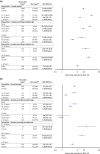Features of Inflammatory Heart Reactions Following mRNA COVID-19 Vaccination at a Global Level
- PMID: 34860360
- PMCID: PMC9015432
- DOI: 10.1002/cpt.2499
Features of Inflammatory Heart Reactions Following mRNA COVID-19 Vaccination at a Global Level
Abstract
Myocarditis and pericarditis may constitute adverse reactions of mRNA coronavirus disease 2019 (COVID-19) vaccines. This study aimed to document these reactions and to assess the association with patient sex and age. This is as an observational retrospective study using a case-non-case design (also called disproportionality study) on inflammatory heart reactions reported with mRNA COVID-19 vaccines within the World Health Organization (WHO) global safety database (VigiBase), up to June 30, 2021. Results are expressed using reporting odds ratios (RORs) and their 95% confidence interval (95% CI). Of 716,576 reports related to mRNA COVID-19 vaccines, 2,277 were cases of inflammatory heart reactions, including 1241 (55%) myocarditis and 851 (37%) pericarditis. The main age group was 18-29 years (704, 31%), and mostly male patients (1,555, 68%). Pericarditis onset was delayed compared with myocarditis with a median time to onset of 8 (3-21) vs. 3 (2-6) days, respectively (P = 0.001). Regarding myocarditis, an important disproportionate reporting was observed in adolescents (ROR, 22.3, 95% CI 19.2-25.9) and in 18-29 years old (ROR, 6.6, 95% CI 5.9-7.5) compared with older patients, as well as in male patients (ROR, 9.4, 95% CI 8.3-10.6). Reporting rate of myocarditis was increased in young adults and adolescents. Inflammatory heart reactions may rarely occur shortly following mRNA COVID-19 vaccination. Although an important disproportionate reporting of myocarditis was observed among adolescents and young adults, particularly in male patients, reporting rates support a very rare risk, that does not seem to compromise the largely positive benefit-risk balance of these vaccines. Furthermore, this study confirmed the value of disproportionality analyses for estimation of relative risks among subgroups of patients.
© 2021 The Authors. Clinical Pharmacology & Therapeutics published by Wiley Periodicals LLC on behalf of American Society for Clinical Pharmacology and Therapeutics.
Conflict of interest statement
The authors declared no competing interests for this work.
Figures




Similar articles
-
Incidence, risk factors, natural history, and hypothesised mechanisms of myocarditis and pericarditis following covid-19 vaccination: living evidence syntheses and review.BMJ. 2022 Jul 13;378:e069445. doi: 10.1136/bmj-2021-069445. BMJ. 2022. PMID: 35830976 Free PMC article. Review.
-
Comparative safety profile of bivalent and original COVID-19 mRNA vaccines regarding myocarditis/pericarditis: A pharmacovigilance study.Int Immunopharmacol. 2024 May 30;133:112022. doi: 10.1016/j.intimp.2024.112022. Epub 2024 Apr 13. Int Immunopharmacol. 2024. PMID: 38615382
-
Adverse Events Following COVID-19 Vaccination in Adolescents: Insights From Pharmacovigilance Study of VigiBase.J Korean Med Sci. 2024 Mar 4;39(8):e76. doi: 10.3346/jkms.2024.39.e76. J Korean Med Sci. 2024. PMID: 38442719 Free PMC article.
-
Global estimates on the reports of vaccine-associated myocarditis and pericarditis from 1969 to 2023: Findings with critical reanalysis from the WHO pharmacovigilance database.J Med Virol. 2024 Jun;96(6):e29693. doi: 10.1002/jmv.29693. J Med Virol. 2024. PMID: 38859751
-
Reports of myocarditis and pericarditis following mRNA COVID-19 vaccination: a systematic review of spontaneously reported data from the UK, Europe and the USA and of the scientific literature.BMJ Open. 2022 May 25;12(5):e059223. doi: 10.1136/bmjopen-2021-059223. BMJ Open. 2022. PMID: 35613761 Free PMC article.
Cited by
-
Major Adverse Cardiovascular Events Related to JAK Inhibitors: A Disproportionality Analysis Using the WHO Global Individual Case Safety Database.Drug Saf. 2025 Aug;48(8):943-952. doi: 10.1007/s40264-025-01535-8. Epub 2025 Mar 23. Drug Saf. 2025. PMID: 40121611 Free PMC article.
-
Myopericarditis in a Male Adolescent Following the Second Shot of COVID-19 Pfizer m-RNA Vaccine: Typical Example and Analysis of 110 Single Case Reports.Pediatr Rep. 2022 Sep 26;14(4):401-409. doi: 10.3390/pediatric14040048. Pediatr Rep. 2022. PMID: 36278552 Free PMC article. Review.
-
Adverse Events and Safety Profile of the COVID-19 Vaccines in Adolescents: Safety Monitoring for Adverse Events Using Real-World Data.Vaccines (Basel). 2022 May 9;10(5):744. doi: 10.3390/vaccines10050744. Vaccines (Basel). 2022. PMID: 35632500 Free PMC article.
-
Two pediatric cases of multisystem inflammatory-like syndrome following COVID-19 vaccination.Arch Pediatr. 2022 Nov;29(8):620-623. doi: 10.1016/j.arcped.2022.08.018. Epub 2022 Sep 26. Arch Pediatr. 2022. PMID: 36283888 Free PMC article.
-
Incidence, risk factors, natural history, and hypothesised mechanisms of myocarditis and pericarditis following covid-19 vaccination: living evidence syntheses and review.BMJ. 2022 Jul 13;378:e069445. doi: 10.1136/bmj-2021-069445. BMJ. 2022. PMID: 35830976 Free PMC article. Review.
References
-
- Eckart, R.E. et al. Incidence and follow‐up of inflammatory cardiac complications after smallpox vaccination. J. Am. Coll. Cardiol. 44, 201–205 (2004). - PubMed
Publication types
MeSH terms
Substances
Grants and funding
LinkOut - more resources
Full Text Sources
Medical

